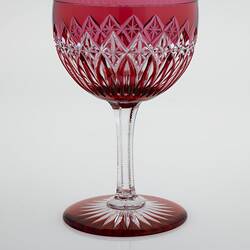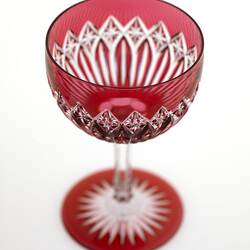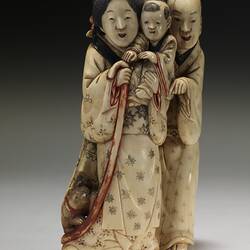Summary
Ruby 'cut to clear' glass wine goblet, probably manufactured in England, circa 1860-1890.
'Cut to clear', a decorative technique applied to glassware in the nineteenth century, involved dipping colourless glass into a coloured glass base while the object was being formed. When it came time to decorate the item, the glass cutter would cut deep patterns, often geometric, into the surface of the glass, removing the outer layer of coloured glass, and allowing the colourless base glass to show through.
Although it is thought that the Romans discovered the technique of producing ruby (sometimes known as cranberry) glass, it was not untilt he seventeenth century that it was 'rediscovered', rising in popularity during the Victorian period in the nineteenth century. Originally produced in Bohemia, the source for some of Europe's finest glassware at the time, by the 1850s glass manufacturers in England were also producing ruby glassware. Unlike the Bohemian produce, which has a very strong, deep red colour, English ruby glass tends to be softer, and at times almost pinkish in colour.
While various English glassworks applied the technique, the West Midland factories around Stourbridge were particular noted. At the 1888 Melbourne Centennial International Exhibition, the Stourbridge-based firm of Stuart and Sons were singled out in the Australian press for their fine display of glassware.
'The shading of the colours in all cases is marvellous', the Argus newspaper observed, 'considering the nature of the material in which such effects are obtained. Ruby glass is well represented, and there are some richly cut crystal lamps, of which Messrs. Stuart and Sons have made a specialty'.
Physical Description
Ruby bowl on slender stem with ruby foot the same diameter as the bowl. Cut diamond and star pattern around bowl. Serration down clear glass stem. No markings.
More Information
-
Collection Names
-
Collecting Areas
-
Acquisition Information
Cultural Gifts Donation from Dr Will Twycross, 23 Jan 2009
-
Acknowledgement
Donated through the Australian Government's Cultural Gifts Program
-
Place & Date Made
-
Place & Date Exhibited
Royal Exhibition Building (REB), Nicholson Street, Carlton, Greater Melbourne, Victoria, Australia, 1880-1881
-
Collector
Mr John Twycross, Elsternwick, Greater Melbourne, Victoria, Australia, 1881
-
Classification
Royal exhibition building, International exhibitions, Exhibition heritage
-
Category
-
Discipline
-
Type of item
-
Overall Dimensions
80 mm (Width), 125 mm (Height)
-
Maximum dimensions
121 (Height), 72 (Outside Diameter)
Measurement From Conservation.
-
References
Peter Cook, 'Collectors Corner', in Australian Women's Weekly, Wed., 9 August 1978, p.137 Argus, Melbourne Centennial Exhibition Supplement, Tues., 2 October 1888, p.46
-
Keywords
Decorative Arts, Exhibitions: Melbourne International, 1880-1881, Glass, Royal Exhibition Building



